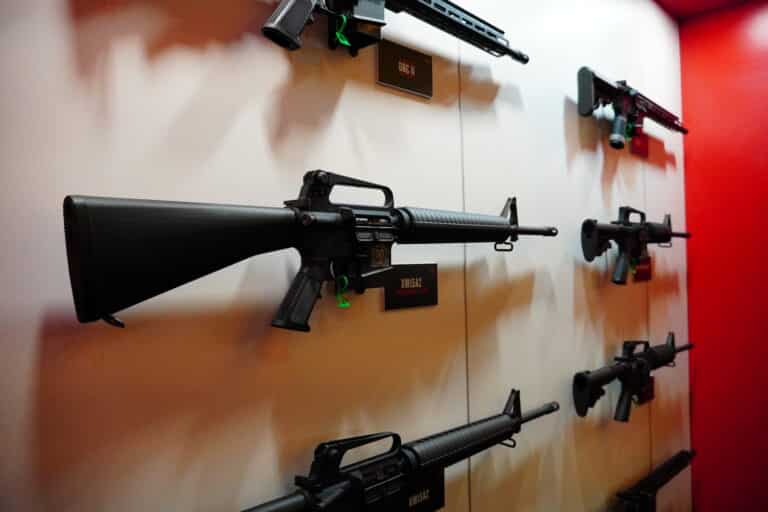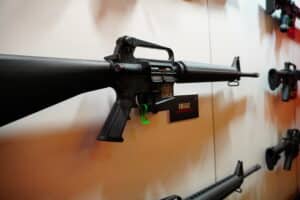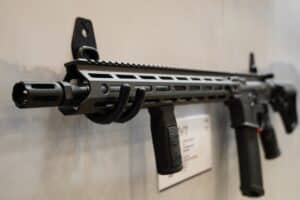After more than a year of effort and two failed prior attempts, Bay State lawmakers officially got a Bruen-response bill enacted into law this week.
Massachusetts Governor Maura Healey signed H.4885 into law on Thursday. The signing ceremony was the culmination of several months of negotiations between gun-control advocates in the state’s House and Senate after previous bills died in the legislature.
Clocking in at 116 pages in length, there are few realms of firearms regulation that the measure doesn’t touch. Here’s a look at what some of the most significant changes in H.4885 will mean for Massachusetts gun owners.
“Assault-Style Firearms” and Magazine Restrictions
The new law expands the state’s already extensive prohibition on so-called assault weapons by broadening the definition of which guns are included under the ban. Under H.4885, “no person” shall “possess, own, offer for sale, sell or otherwise transfer” an “assault-style firearm” or “large capacity feeding device.”
The law defines an assault-style firearm as any semiautomatic centerfire rifle or semiautomatic pistol capable of accepting a detachable magazine that also has two or more cosmetic or ergonomic features typically associated with assault weapon bans. They include things like folding or telescopic stocks, forward grips, threaded barrels, and barrel shrouds. The law also applies to any semiautomatic shotgun, regardless of whether they accept detachable magazines, if they contain two or more of the banned features.
In addition to the newly-added features-based test, the law carries over the ban on dozens of specific firearms by make and model, as well as any firearm listed on the state’s “assault-style firearm roster,” which the state’s Firearm Control Advisory Board is tasked with maintaining and updating at its discretion. The law also allows anyone to petition the board to add or remove firearms from the roster. Furthermore, the law bans any “copy or duplicate” of a firearm listed in the statute or on the assault-style firearm roster.
There are a handful of exceptions to the law’s possession ban, however. Those who possessed an assault-style firearm prior to August 1, 2024, registered the weapon with the state, and have a valid license to carry are grandfathered in. As are those who legally purchased what the state labels copies of banned guns before July 20, 2016–the day Governor Maura Healey (D.), who was Attorney General at the time, announced she was re-interpreting state law to ban the guns.
Large-capacity feeding devices—defined by the law as any fixed or detachable magazine, drum, or belt capable of holding more than 10 rounds of ammunition or more than 5 shotgun shells—are completely banned unless they were previously owned before September 13, 1994.
Carry Restrictions and Permitting Requirements
While ostensibly a Bruen-response bill, H.4885’s restrictions on gun carry are less onerous than the response bills passed in other formerly may-issue states. It creates new “prohibited areas,” similar to the sensitive places crafted in other bills. However, it limits them to state, county, and municipal government property as well as within 150 feet of any polling place.
H.4885 also adds new training requirements for people seeking a license to carry. The law tasks the colonel of state police with crafting uniform safety training standards that must include both a written and live fire exam. Courses must also cover “the safe use, handling and storage of firearms; methods for securing and childproofing firearms; the applicable laws relating to the possession, transportation and storage of firearms; knowledge of operation, potential dangers and basic competency in the ownership and use of firearms; injury and suicide prevention and harm reduction education; applicable laws relating to the use of force; disengagement tactics; and live firearms training.”
Those with valid carry licenses issued prior to August 1, 2024 are exempt from having to go through the updated training requirements when renewing their licenses. The law maintains the state’s current $100 application fee and six-year validity window for permits.
“Ghost Gun” Bans
In an attempt to crack down on so-called ghost guns, the law prohibits the possession, manufacture, transfer, and sale of any unserialized firearms made after 1968. It does allow persons otherwise allowed to purchase and possess firearms to continue privately manufacturing them, provided that they are not “assault-style” firearms and that persons serialize them with the Department of Criminal Justice Information Services within seven days.
The law prohibits anyone from using a 3-D printer or CNC machine to make a firearm unless they have a valid license to carry. It also prohibits the sale of any 3-D printer or CNC machine that has “the primary or intended function of manufacturing or assembling firearms,” which will apparently be determined based on the machine’s marketing and promotion.
“Machinegun” Restrictions
The law updates the state’s existing prohibitions on machineguns by also criminalizing the possession of “automatic parts,” defined as any “device, part or combination of parts” capable of being attached to a firearm that “allows for the automatic discharge of more than 1 shot with 1 continuous activation of the trigger” or that “increases the rate of fire of a firearm to mimic automatic fire.” The bill lists bump stocks, rapid-fire trigger activators, and trigger modifiers like cranks and binary triggers as falling under that definition. The bill specifically exempts adjustments made to the trigger pull weight of a firearm, though.
Extreme Risk Protection Order Expansion
H.4885 significantly expands the categories of people eligible to petition a judge to initiate Massachusetts’ existing emergency gun confiscation law.
Previously, only family members or law enforcement were permitted to request an extreme risk protection order.
The new law will now allow licensed physicians, registered nurses, licensed practical nurses, certified nurse practitioners, certified clinical nurse specialists, certified psychiatric clinical nurse specialists, licensed psychiatrists, licensed psychologists, licensed mental health counselors, licensed marriage and family therapists, licensed independent clinical social workers, licensed certified social workers, a principal or assistant principal of an elementary school or secondary school, and administrators of a college or university where the respondent is enrolled to file petitions.
Miscellaneous
The law also tasks the state legislature with convening a special commission to “study and investigate emerging firearm technology.” Specifically, the 13-member commission will be required to study the “status, feasibility, and utility” of smart guns and microstamping technology, including the cost and impacts associated with “requiring” their use in Massachusetts. The law directs the commission to complete its study and issue legislative recommendations no later than March 1, 2025.
Additionally, the 116-page law is littered with new administrative record-keeping, information disclosure, and training requirements for firearms retailers and various state agencies.
Overall, the bill is much less akin to the Bruen-response laws gun owners have grown accustomed to seeing in states like California and New York, and much more like a grab bag of various gun control policy goals. It will likely prove to be just as prone to legal challenges from gun-rights advocates, though.







3 Responses
Wow. Where to begin? “By the sword we seek peace, but peace only under liberty” Motto of Massatwoshits. It would seem that their politicians are bringing the sword to the state’s gun owners.
“No matter the form of government: democracy, republic, monarchy, oligarchy, theocracy, socialist, communist, capitalist… what the People allow the government to do in their name, determines what kind of country they are. Whether they are a country that has individual freedom, liberty, and individual rights protected by the government, or if those people are controlled by the government and meted privileges, instead of guaranteed rights – will show what they are, what they have allowed themselves and their children to become. “
Well, we see how this is going to go for the average, law abiding, gun owner.
Minor correction. In the article, you forgot to mention that there is an exemption for LEOs. See lines 1550 – 1554 on page 74 of the PDF.